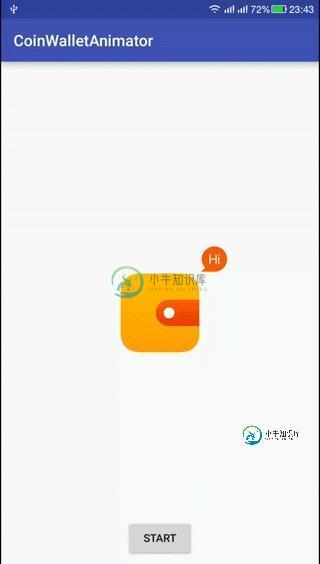Android仿荷包APP启动动画
用荷包App的时候发现启动动画做的挺好玩的,于是便模仿实现了一下。
gif效果图:

animation.gif
实现思路:
仔细观察,可以看出动画的执行分为两个阶段:
第一阶段为硬币掉落。
第二阶段为钱包反弹。
布局xml文件如下:
<?xml version="1.0" encoding="utf-8"?>
<FrameLayout xmlns:android="http://schemas.android.com/apk/res/android"
xmlns:tools="http://schemas.android.com/tools"
android:layout_width="match_parent"
android:layout_height="match_parent"
android:orientation="vertical"
tools:context=".MainActivity">
<ImageView
android:id="@+id/coin_iv"
android:layout_width="wrap_content"
android:layout_height="wrap_content"
android:layout_gravity="center"
android:src="@mipmap/coin"/>
<ImageView
android:layout_width="wrap_content"
android:layout_height="wrap_content"
android:layout_gravity="center"
android:layout_marginBottom="70dp"
android:layout_marginLeft="70dp"
android:src="@mipmap/version"/>
<ImageView
android:id="@+id/wallet_iv"
android:layout_width="wrap_content"
android:layout_height="wrap_content"
android:layout_gravity="center"
android:src="@mipmap/wallet"/>
<Button
android:id="@+id/start_btn"
android:layout_width="wrap_content"
android:layout_height="wrap_content"
android:layout_gravity="center|bottom"
android:layout_marginBottom="10dp"
android:text="start"/>
</FrameLayout>
硬币掉落:
硬币掉落的过程中执行两种动画,位移和旋转。
位移动画使用了补间动画,xml文件如下:
<?xml version="1.0" encoding="utf-8"?> <translate xmlns:android="http://schemas.android.com/apk/res/android" android:fromYDelta="-50%p" android:interpolator="@android:anim/accelerate_interpolator" android:toYDelta="0%"/>
旋转动画采用了重写Animation并利用android.hardware.Camera类来实现。
public class ThreeDRotateAnimation extends Animation {
int centerX, centerY;
Camera camera = new Camera();
@Override
public void initialize(int width, int height, int parentWidth, int parentHeight) {
super.initialize(width, height, parentWidth, parentHeight);
// 中心点坐标
centerX = width / 2;
centerY = height / 2;
setDuration(500);
setInterpolator(new LinearInterpolator());
}
@Override
protected void applyTransformation(float interpolatedTime, Transformation t) {
final Matrix matrix = t.getMatrix();
camera.save();
// 绕y轴旋转
camera.rotateY(360 * interpolatedTime);
camera.getMatrix(matrix);
// 设置翻转中心点
matrix.preTranslate(-centerX, -centerY);
matrix.postTranslate(centerX, centerY);
camera.restore();
}
}
这里简单说下animation里面的preTranslate和postTranslate方法,preTranslate是指在rotateY前平移,postTranslate是指在rotateY后平移,注意他们参数是平移的距离,而不是平移目的地的坐标!
由于旋转是以(0,0)为中心的,所以为了把硬币的中心与(0,0)对齐,就要preTranslate(-centerX, -centerY), rotateY完成后,调用postTranslate(centerX, centerY),再把图片移回来,这样看到的动画效果就是硬币从中心不停的旋转了。
最后同时执行以上两种动画,实现掉落旋转效果。
private void startCoin() {
// 掉落
Animation animationTranslate = AnimationUtils.loadAnimation(this,R.anim.anim_top_in);
// 旋转
ThreeDRotateAnimation animation3D = new ThreeDRotateAnimation();
animation3D.setRepeatCount(10);
AnimationSet animationSet = new AnimationSet(true);
animationSet.setDuration(800);
animationSet.addAnimation(animation3D);
animationSet.addAnimation(animationTranslate);
mCoinIv.startAnimation(animationSet);
}
钱包反弹:
在执行硬币掉落的同时,启动一个ValueAnimator动画,来判断钱包反弹的时机。
private void setWallet() {
final ValueAnimator valueAnimator = ValueAnimator.ofFloat(0, 1);
valueAnimator.setDuration(800);
valueAnimator.addUpdateListener(new ValueAnimator.AnimatorUpdateListener() {
@Override public void onAnimationUpdate(ValueAnimator animation) {
float fraction = animation.getAnimatedFraction();
// 大概掉落到钱包的上边缘位置的时候,取消ValueAnimator动画,并执行钱包反弹效果
if (fraction >= 0.75) {
valueAnimator.cancel();
startWallet();
}
}});
valueAnimator.start();
}
最后执行钱包反弹效果动画,这里采用了ObjectAnimator 。
private void startWallet() {
// x轴缩放
ObjectAnimator objectAnimator1 = ObjectAnimator.ofFloat(mLogoIv, "scaleX", 1, 1.1f, 0.9f, 1);
objectAnimator1.setDuration(600);
// y轴缩放
ObjectAnimator objectAnimator2 = ObjectAnimator.ofFloat(mLogoIv, "scaleY", 1, 0.75f, 1.25f, 1);
objectAnimator2.setDuration(600);
AnimatorSet animatorSet = new AnimatorSet();
animatorSet.setInterpolator(new LinearInterpolator());
// 同时执行x,y轴缩放动画
animatorSet.playTogether(objectAnimator1, objectAnimator2);
animatorSet.start();}
这样一个简单的荷包启动动画效果就差不多出来了,唯一遗憾的是对钱包进行y轴缩放的时候会对整个y轴进行缩放,要想保持钱包底部不动,只有钱包上部反弹,暂时还没有想到什么好的方法,小弟不才还望大神赐教!谢谢!
完整源码:
完整源码在GitHub
如果觉得还不错,记得star╰( ̄▽ ̄)╮哟~
以上就是本文的全部内容,希望对大家的学习有所帮助,也希望大家多多支持小牛知识库。
-
无法在仿真程序中启动AVD。 输出: 模拟器:警告:将VM堆大小设置为低于硬件指定的最小值128MB模拟器:警告:将VM堆大小设置为128MB qemu-system-i386.exe:-drive if=none,index=1,id=cache,file=c:\users\haris.android\avd\nexus_5_api_19.avd/cache.img:无法打开磁盘映像c:\use
-
我正在创建一个运行在Eclipse之外的无头OSGI服务器。我使用Jetty作为我的Servlet容器,使用Equinox作为我的OSGI容器。我正在使用包将Jetty添加到OSGi中。如果我从提示符手动启动jetty和org.eclipse.equinox.http.registry,那么它就可以正常运行。但是,我希望这是在无人值守的情况下运行的,所以我需要在OSGi启动时自动(或者至少是编程方
-
问题内容: 从我在Stack Exchange和其他地方看到的所有内容中,我已经正确设置了所有内容,可以在启动Android OS时启动IntentService。不幸的是,它没有在启动时启动,并且我没有收到任何错误。也许专家可以帮忙… 表现: 用于启动的BroadcastReceiver: 更新:我尝试了下面的几乎所有建议,并;在处理程序中添加了日志记录,但从未记录过任何内容。因此,它甚至还没有
-
通过应用程序中心部署React-Native应用程序时发生问题-在本地执行时没有崩溃。 IOS构建、部署和运行并成功构建。 在Android中-构建成功通过,但当我安装应用程序时,它在启动时崩溃。 当我检查logcat时,我看到了下面的错误——看起来这个版本是一个调试版本(metro提到过),但我不确定。 可能是什么问题? 2021-11-09 08:54:36.227 21255-21326/?
-
本文向大家介绍Android App应用启动分析与优化,包括了Android App应用启动分析与优化的使用技巧和注意事项,需要的朋友参考一下 app的启动方式: 1.)冷启动 当启动应用时,后台没有该应用的进程,这时系统会重新创建一个新的进程分配给该应用,这个启动方式就是冷启动。冷启动因为系统会重新创建一个新的进程分配给它,所以会先创建和初始化Application类,再创建和初始化Main
-
问题内容: 我直接使用默认的os拨号器通过以下方式创建呼叫: 是否可以直接从我的应用程序启动Skype? 我尝试传递一个数字,如下所示: 传递数字失败。 问题答案: 您需要知道Skype软件包名称(例如com.skype.android),然后才能启动它:

